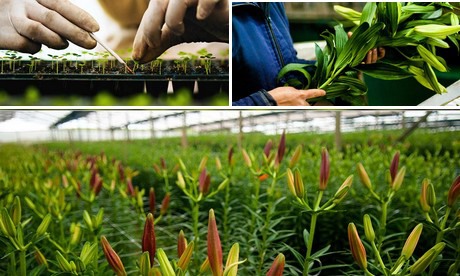
Brazilian flower market
"Nowadays, mainly cut flowers, like roses, alstroemerias, gerberas and lilies are being cultivated in Brazil." According to Hattnher, roses, alstroemerias and chrysanthemums are the most popular flowers among the Brazilian customers and therefore the most popular flowers to grow are chrysanthemum, followed by roses and alstroemeria." Chrysanthemums are popular with the growers, because they're easier to grow than roses, for example. The alstroemerias are becoming increasingly popular to grow, the Brazilian cultivation acreage of alstroemerias is growing very fast," she says.
Mostly grown in plastic greenhouses
The majority of the flowers in Brazil are cultivated in plastic greenhouses. "There are still some open fields, but especially the varieties that are sensitive to diseases, like chrysantemums, roses, gerberas, alstroemerias and lilies, are grown in a greenhouse."
More import than export
According to Hattnher, more flowers are being imported than exported. "Currently, only a small amount of flowers are being exported; mainly flower bulbs to the Netherlands," says Hattnher. According to Hattnher, this is due to the current financial situation in Brazil. “Brazil is facing economic problems, and so is the flower demand. In the winter months, the production falls, and that´s when the imports enter the Brazilian market. According to Hattnher, roses, alstroemerias, and gypsophila are mainly imported from Colombia and Ecuador. And for this reason, these countries are also the main competitors of the Brazilian flower growers," she says.
Higher production costs
Over last years, the percentage of flower growers increased. However, due to the revaluation of the dollar, they are currently experiencing some difficulties; the production costs for growing flowers increased. "Many growers buy their greenhouse supplies in dollars. So, when the value of the dollar increases, the product costs will do too," says Hattnher. In spite of the higher production costs, Hattnher still expects an increase in the number of growers in the coming years.
Cooperflora
Cooperflora is an organization that connects and supports Brazilian growers with their customers in Brazil. "Based on an online database, our sales system is populated by the flower-growers, making information available, including quantity, quality, price, and delivery time. All this information is accessed by customers via the Internet or through a contact with our Commercial team support. Cooperflora also has an internal distribution system which assures a successful product supply in Brazil. There are over 300 customers in our records and commercialization is around 350 product types."
For more information
Coope
 rflora
rflora Fernanda Hatthner
Email: [email protected]
www.cooperflora.com.br
